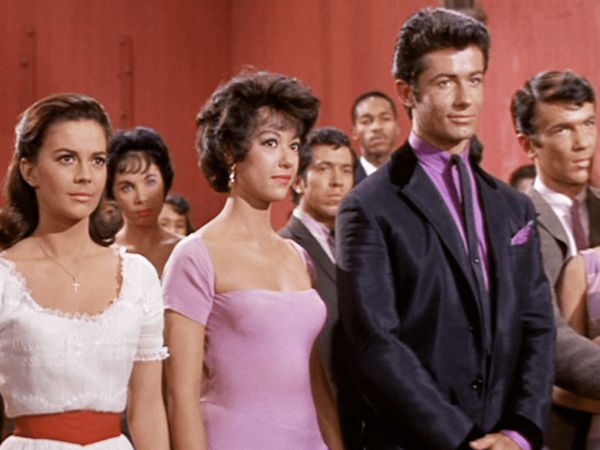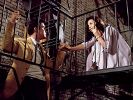Eye For Film >> Movies >> West Side Story (1961) DVD Review
West Side Story
Reviewed by: Andrew Robertson
Read Andrew Robertson's film review of West Side Story
This was a two-disc DVD release, and most of its additional features are on the second. One that retains ,novelty is the original intermission/walk-in music, those stylised silhouettes of skyline against bright coloured backgrounds while an instrumental plays behind it. The scene selection menu is animated too, eight sets of four with the first shots set out to help you find things. Given that it's a musical it might have been nice to have the songs queued as well, but that would probably require an additional set of chapter marks.
The documentary West Side Memories explores the making of the film. There's the addition of the prologue, with stories of the troubled location shoot in New York. Those are the actual streets, some of which were cleared for the construction of the Lincoln Center. Anyone who's complained about the cinematic topography of the London Underground will appreciate just how far the Jets cover with a single jump, and anyone who's spent time in production will appreciate why they had to ban "rain dances". West Side Memories features extensive interviews and behind the scenes footage. There's a lot of talk of the changes Robbins made, a quote from co-director Robert Wise of "you can never have too many angles" seems apt and there's a lot of perspective on their competing styles and attitudes.

What's striking is to realise just how much was filmed in New York, and the distinction between those scenes and the stuff done on stages is actually less apparent than thought. An unsung hero of it all is Betty Walberg, on-set pianist. She'd been the rehearsal pianist, and in some of the footage in the documentary you can hear her run through the complex counts. At that point it really becomes clear the extent to which West Side Story was both a musical and a film, even as it was being filmed. That knowledge of creative tension helps the tension of the film itself. Robbins was removed before the filming of the Gymnasium sequence, and though banned from the set Robert Wise not only brought him back for editing but invited him to the Oscars.
There's a lot of discussion of the structure and the roles. The dubbing and over-dubbing are complicated enough, but there's some useful examination of the weakness of the role of Tony. Something that Spielberg's version works on, one of the songs mentioned as being flashy and for the gangs is Cool, and as a duet before the rumble it gives Ansel Elgort a different place to shine. Rita Moreno's one of the many talking heads and her return in 2021's version gets even more depth when she talks about how traumatic it was filming as Anita delivering the message to Doc's drugstore. The documentary interviews were shot in 2003, but even then many of those involved were not available. The tributes to Robert Wise, Leonard Bernstein, and Jerome Robbins all feel heartfelt.
Some of the revelations are about the stage play itself. The speech at the end turns out to have been a song's dummy lyrics, a tune for them never found and working without it. The construction of Maria is born in Wise's history as an editor, shots that make up Tony's walk almost bookend the production, certainly the soundstage shots. That the prologue was actually shot in New York and followed a then novel aerial view of the city's streets gives it a further weight. Boris Leven's production design and insights into storyboarding are fascinating, but interviews with the cast (particularly Moreno and Richard Beymer) are insightful.
There's discussion of its impact upon release, the critical and cultural and commercial success. That we're talking about it still isn't just because a version of it is on screens again, the four years of buzz producing an audience ready to see it. There's some astonishing shots of a 40th anniversary screening in New York, which drew full crowds in October of 2001. The documentary was written/produced/directed by Robert Marick, one of MGM's VPs of something corporate. It's a competently executed mixture of interview and archive, not especially dazzling but strengthened by what it has to reveal. At about 55 minutes it's a pleasant watch with a cup of tea, and provides a number of useful trails for further research.
The DVD also includes production designs and storyboards and the final shorts. That's the work of Boris Leven and Maurice Zuberano, including versions of scenes (and songs) planned but unrealised. These include a ballet around 'Somewhere'. There's also an extended series for Tony's long walk of Maria, and one of the things that's striking is not just how varied the backgrounds are but the stylistic differences in the art. One drawing alone, blurry neon and blurrier taxi, and then its celluloid successor almost serve as harbinger of the entirety of Scorsese' career. They're available both as a montage and a gallery, and the montage works better -not least because of the music, but pacing. It's just under five minutes in length but it absolutely flies by. The gallery is interesting though, flicking through Leven's painted designs with iconic features already present like Maria's almost Mondrian bedroom door, Zuberano's watercolour sketches of Manhattan for the prologue wouldn't disgrace as Gotham in some latter version of Batman. With a lot of the storyboard sketches there's already a sense of motion, legs lean and loom foreshadowing Robert Crumb, the ubiquity of branding means you can see Coca Cola on the crates even in this drawing that is rescued from ephemera by this DVD extra. The galleries flick by, there were moments that I had trouble navigating them. The storyboard one has 84 chapters in its six minutes and the transitions seem to have caused my DVD player some unhappiness. State of the art for 2003 though, going into a DVD player specifically selected for the option to jailbreak it. There may be a better way to recover them for those curious, but they're not full screen being surrounded by a block and colour frame with chain link and photographic textures. This does somewhat limit their utility as a source for scholarship, but I suspect they may be collected elsewhere.
There are ten "lumps" of behind the scenes stills, Jerry Robbins auditioning in a huge space, Natalie Wood's rehearsals, and so on. While they're interesting, it's possibly even less useful than the storyboards to have them presented in this way. The DVD extras include a variety of subtitles, but properly end with no less than four trailers. An animated one recalls not only the storyboard art but the work of Saul Bass, all outline and colour with an instrumental you'd recognise over the top. When the score becomes strident the art changes too, multicoloured, almost suggesting Soviet Realist outlines. The fire escapes become a recurring labyrinth, abstract skylines with major roles credited. Striking to see it described as 'released thru [sic] United Artists' too. There are two versions of another trailer, which shows plenty of film grain and crackle from its recovery. "Unlike other classics, West Side Story grows younger".
It's interesting to compare to modern trailers if only because it (unlike some for Cyrano) makes it clear it's a musical, and reveals a major plot point. It also 'spoils' the focus artifact that shows the tunnel vision of the lovers in the gymnasium, indeed there's a good portion of the last scene in it. I do admire the four way split screen that shows just how kinetic the film can be in places, but it's hard to consider it a useful reflection of the film, however accurate. There's also the 'Academy Award Winning...' version, though they're the wrong way round in the menu. The 'original theatrical' seems a little unusual too, if only because of the number of press clippings within it, but film releasing was different then and even more different now.
Reviewed on: 27 Jan 2022














